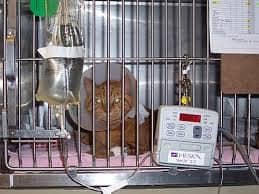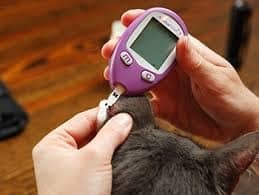Diabetic ketoacidosis (DKA) is one of the most extreme complications of diabetes mellitus that can occur. Unfortunately, most cases of ketoacidosis are in patients that were not previously known to be diabetic so both pet and owner face two serious diagnoses seemingly out of the blue: one life-threatening and expensive and the other requiring on-going commitment and daily treatment.

The diabetic patient cannot produce enough insulin (type I) or its cells are resistant to the effects of insulin (type 2) Insulin is the substance that enables the cells to take in and utilize blood glucose/sugar. Insulin production and utilization are also affected by concurrent illnesses such as pancreatitis and even urinary tract infections.
If glucose is not getting taken up into the cells, body tissues, including the brain, become especially desperate and the body begins to break down fat to liberate the small amount of carbohydrate (which can be converted to glucose) contained in the fat.
Fat is converted to a biochemical substance called a ketone body. Ketone bodies can be used as an alternative fuel source by tissues that require glucose (brain, red blood cells etc.). This will save the day in the short term but ketones have serious side effects including being very acidic. When ketone bodies are burned, the blood becomes acidic and electrolyte imbalances ensue. These imbalances coupled with the loss of glucose in the urine create dehydration, which in turn creates more acidic and electrolyte imbalances. In short, a disaster results if this continues to cycle.
Most patients in diabetic ketoacidosis are lethargic, depressed, and will not eat. They are dehydrated and frequently nauseated. Blood glucose is extremely high and ketones can be found in the urine. The goal is to gradually correct all the imbalances, get the patient out of the extreme fat-burning state, and establish some sort of initial regulation of the diabetes.
Prognosis is generally fair as long as the complicating disease (the disease that is happening on top of the diabetes mellitus such as pancreatitis) can be resolved. That said, round-the-clock monitoring of electrolytes and blood sugar is needed to safely get the patient through the crisis, and this care is expensive. Ketoacidosis involves potential disasters in potassium, phosphorus, pH, blood sugar, and sodium. All of these parameters must be controlled. The goal is to convert the complicated diabetic patient into an uncomplicated diabetic patient, and then the patient can be managed as a “normal’ diabetic.
What to Expect in the Hospital
The sooner the crisis is recognized, the faster treatment can be started. Because crucial blood substances can shift rapidly during treatment, blood testing is necessary throughout the day to keep track and stay up to date with correcting the imbalances. A facility that offers 24-hour care is ideal.
In dogs, the most common inciting/concurrent conditions are: pancreatitis, urinary tract infection, and Cushing’s disease. In cats, precipitating/concurrent conditions include: hepatic lipidosis, kidney infection, pancreatitis, and cholangiohepatitis.

Intravenous Fluids
Intravenous fluid therapy is an essential part of treatment. The patient is very dehydrated from the illness, which causes excess urination as well as from vomiting and/or diarrhea. Aside from simply providing fluids, the IV fluids can have other things added to it such as potassium and insulin to help correct other metabolic derangements.
Insulin
Blood sugar must be controlled if treatment is to be successful but to prevent brain damage, blood sugar levels must be dropped slowly. To achieve this, “regular insulin” (typically Humulin R®) is used, given either as multiple intramuscular injections or as a continuous drip. This type of insulin is short acting and wears off quickly, which allows it to provide small adjustments. It is not until the patient is eating and nausea has been controlled that a maintenance long-acting insulin can be started.
Potassium
Patients in ketoacidosis are greatly depleted in potassium. While insulin is needed to control blood sugar, insulin makes the problem worse by driving potassium into the body’s cells and out of the bloodstream. Typically, high amounts of potassium must be supplemented in the intravenous fluid solution.
Phosphorus
Low levels of phosphorus also accompany diabetic ketoacidosis and if levels drop too low, the patient’s red blood cells will begin to burst and be unable to maintain integrity. Phosphorus is also supplemented through the intravenous fluid solution.
Blood pH
The term ketoacidosis implies that the blood pH is overly acidic. If the situation is severe enough, sodium bicarbonate (a basic substance) must be added to the intravenous therapy.
All these aspects require regular monitoring, which means lab work perhaps four times daily or more. Patients in diabetic ketoacidosis require close monitoring and intensive care.

When ketones are no longer in the urine and the patient is eating well and in good spirits, he or she is able to go home and be managed as a regular diabetic. Diet, blood sugar monitoring, and insulin adjustments will be on-going things for you and your veterinarian to do to get your diabetic patient’s disease under control.


